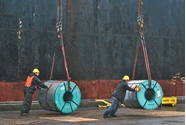Prices

May 30, 2023
Import Data Has Yet to Show Expected Surge
Written by Laura Miller
An anticipated surge in flat-rolled steel imports due to higher domestic pricing has yet to be reflected in government data.
For monthly imports, the International Trade Administration’s US Steel Import Monitor tracks license applications (a first look showing licenses to import but not necessarily the actual tonnages that entered during the month), a preliminary count, and later a final count. The latest figures released are preliminary April numbers, considered below. You can also view SMU’s analysis of April licenses for additional details.
![]() While the preliminary count of total April imports, at 2,370,569 net tons, came in 2.5% higher than April’s license count, the preliminary flat-rolled import count, at 744,856 tons, was 4.7% lower than the month’s license count.
While the preliminary count of total April imports, at 2,370,569 net tons, came in 2.5% higher than April’s license count, the preliminary flat-rolled import count, at 744,856 tons, was 4.7% lower than the month’s license count.
Total steel imports, at 2,370,569 tons in April’s preliminary count, now show a 9.4% month-on-month (MoM) drop from March’s final count of more than 2,617,667 tons.
The decline in flat-rolled imports from March to April was higher than initially thought as April licenses were 4.9% higher than April’s preliminary figure of 744,911 tons. Thus, April flat-rolled imports showed a 15.4% MoM decline from March’s final 880,332 tons.
The flat-rolled product showing the biggest disparity between license and preliminary figures was tin plate. While the April license count of 110,126 tons showed a MoM rise from March’s final 101,219 tons, the April preliminary figure came in much lower at 84,177 tons, meaning tin plate imports actually fell 17% MoM.
The MoM decline in pipe and tube imports was much less severe than originally thought. While April licenses suggested a 6.9% decline, the preliminary count of 598,658 tons was comparable to March’s final count of 602,826 tons.
Slab imports, at 245,685 tons in April’s preliminary count, were 29% higher than the April license count of 190,241 tons. Thus, April slab imports dropped 47% MoM from March’s recent high of 465,740 tons.
There has been market chatter of a coming surge in imports, with SMU’s market checks and data crunching having shown imports remaining cheaper than domestic pricing for hot-rolled and cold-rolled coil for some time. With domestic prices holding a premium over import tags, the option to import foreign material has been becoming more tempting. The extended delivery time for imports, however, has been reported as a deterrent.
In SMU’s full survey last week, 75% of surveyed manufacturers said foreign suppliers are quoting competitive prices for future delivery. But as one manufacturer said when asked if they are actually buying that foreign material: “No. Pricing offered is quite a bit better than domestic is at time of quote, BUT I’m not sure that it would be when it actually delivers compared to the domestic in that same time. With everything involved in buying offshore, the reward is not a given.”
By Laura Miller, laura@steelmarketupdate.com







